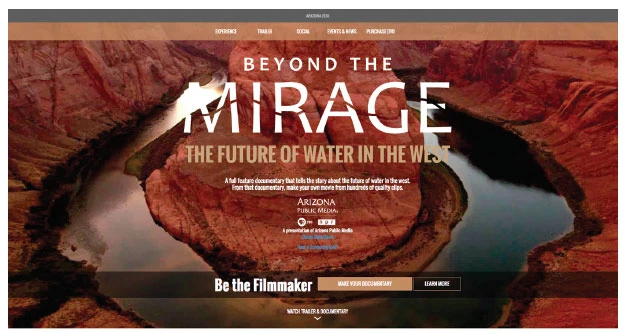Public Policy Review

The Water Resources Research Center is proud to have partnered in the Beyond the Mirage project. Beyond the Mirage got its start as an alternative approach to water education and engagement. While both the Layperson’s Guide to Arizona Water and Keeping Arizona’s Water Glass Full, the background report for the 107th Arizona Town Hall held in November 2015, introduce readers to Arizona water issues, today’s busy schedules and reliance on finger-tip information suggested a new approach was warranted to assist the public in becoming more water-aware. The WRRC’s External Advisory Committee confirmed our plans to develop a new and different platform for water information through partnership with Cody Sheehy and the Communications & Cyber Technologies team of the University of Arizona College of Agriculture and Life Sciences. Envisioned as a multi-part project, Beyond the Mirage would include: (1) a series of short, informative video clips, which the viewer could stack into individualized mini-documentaries; (2) a feature-length documentary, professionally produced in cooperation with Arizona Public Media, with John Booth as our key AZPM partner; and (3) classroom learning media for K-12 students. The clips would include a range of topics and voices. The documentary would be designed to take a broad perspective to a regional or national audience. The WRRC’s role would be to collaborate on identifying important content and interview opportunities, as well as working with Cody and team to review and perfect clips prior to launching the clip stacking web site. Arizona Project WET Director Kerry Schwartz led the K-12 work that engaged middle school students in stack building and sharing. Throughout the effort, Brittany Xiu, Ashley Hullinger, and particularly Susanna Eden worked diligently with Cody, the creative genius behind it all.
Full of ideas and enthusiasm — and with some seed money from the University of Arizona Technology and Research Initiative Fund (TRIF) — the team knew that external resources were needed. The Arizona Community Foundation and its partners presented an exciting and very timely funding opportunity when they announced the New Arizona Prize. It was fortunate that the first competition, the Water Consciousness Challenge, “sought the best digital strategy to raise Arizonans’ consciousness about our water future”. In early April 2015, after a thorough and highly competitive process, the Beyond the Mirage team was awarded the $100,000 prize.
In addition to getting the team together, providing encouragement, and being interviewed, I worked with Cody on the footage filmed in Israel in October 2015, where he used his drone and other professional equipment transported into and out of Israel. We spent five intensive days visiting constructed facilities and natural water sites and talking with several experts. It was a pleasure to see Cody in action. I cannot say enough about his professionalism and ability to quickly absorb new concepts.
The web site BeyondtheMirage.org, which includes over 250 video clips, an artificial intelligence system to guide navigation, and a platform for assembling individual documentaries, was launched in March 2016. I encourage readers to visit the site, view clips, and assemble their own video stacks. In my Arizona Water Policy class, small groups of students assembled mini-documentaries of five minutes, which we then viewed together. It was a fun exercise and interesting to see how the focus of the groups differed. The documentaries can be saved on line, but more importantly they can be shared through social media or email link, effectively spreading water consciousness.
The feature-length documentary, Beyond the Mirage: The Future of Water in the West, was screened and broadcast in April in Tucson. KUAT Channel 6 premiered a 75-minute version of the documentary, which was followed by a panel discussion. In May, KAET Channel 8 in Phoenix aired the 60-minute version of the documentary, which is the version now available on DVD or BluRay. Many have asked if they can access the movie online. Unfortunately, but for good reason, on-line distribution is not yet offered. The team recently received the good news that the film will be made available through the American Public Television (APT) Exchange to public television stations across the country. As explained in the release issued by AZPM, “American Public Television is a leading syndicator of high-quality, top-rated programming”. APT’s policies require that documentaries it airs are not publicly available before they have been aired. Therefore, live-streaming will have to wait until sometime in 2017.
Something that I learned during this project is that, in order for a documentary to be considered for Public Television, the filmmaker must maintain total control over the creative content. This means that, while WRRC staff could do fact checks and share in the end-of-movie credits, Cody was the decision-maker regarding film content.
I am pleased to have been part of the Beyond the Mirage team. The full set of supporters and partners for Beyond the Mirage can be found on the web site. I offer my most sincere thanks to all who contributed their time, expertise, encouragement, and resources. The BeyondtheMirage.org platform is an extraordinary tool that should be kept dynamic and up-to-date. It is true that this will take more resources, but the significant water issues facing our state and region make it imperative that we do so.

